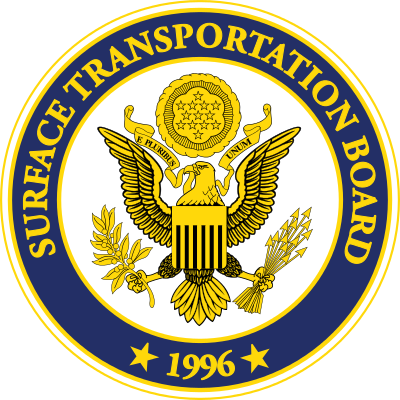STB communicates concern over service issues to Class I railroads
Railroad service issues once again have the attention of the Department of Transportation’s Surface Transportation Board (STB), with STB Acting Chairman Ann Begeman and Vice Chairman Deb Miller penning letters to the top executives at the seven North American Class I railroads, requesting each carrier’s service outlook for both the near term and the rest of 2018.
Railroad service issues once again have the attention of the Department of Transportation’s Surface Transportation Board (STB), with STB Acting Chairman Ann Begeman and Vice Chairman Deb Miller penning letters to the top executives at the seven North American Class I railroads, requesting each carrier’s service outlook for both the near term and the rest of 2018.
“In recent weeks, the Board has become increasingly concerned about the overall state of rail service based on the weekly data collected by the Board pursuant to 49 C.F.R. pt. 1250,” the STB executives wrote. “Although there are exceptions, most Class I railroads’ data indicate that service is deteriorating, while system average dwell time has climbed. For those same railroads, other key metrics-such as the average number of cars in revenue service that have not moved in 48 hours or more-are trending in an unfavorable direction. The Board’s Rail Customer and Public Assistance Staff will begin holding weekly calls with these carriers.”
STB leadership requested that each Class I railroad carrier to provide a written response related to their respective outlooks for rail operations across their networks to address various issues related to rail service adequacy, including: locomotive availability; employee resources; local service performance; demand; communication; and capacity restraints. A deadline for replies from Class Is was not mentioned in the letters.
In the letter, Begeman and Miller also noted that the STB also received letters from the National Grain and Feed Association (NGFA) and the Alliance of Automobile Manufacturers, also known as the Auto Alliance, whom each made it clear they are less than pleased with the current state of the United States freight railroad network, citing “significant degradation in rail service in recent months.”
The Auto Alliance said its members are experiencing substantial consequences, due to service declines and will continue to do so until the underlying causes are resolved. It explained that many of its members dealt with a serious shortage of bi-level and tri-level cars for transporting finished vehicles in February, which has become worse in March.
And it also noted that the railroad industry has significantly missed targets for fulfilling rail car orders, the loaded vs. empty car ratio, and shippable vehicle ground counts, or units awaiting a rail car, as well as delayed loads with no movement in 48 hours up substantially over prior years. The organization said that the overall slowdown in the rail transportation network is delaying the delivery of loaded rail cars and the return of empty rail cars for subsequent loading and the overall inability of railroads to fulfill empty rail car orders.
“The foregoing performance deficiencies cannot be attributed to a spike in demand for transportation of finished vehicles, as no such spike has occurred,” the letter said. “Rather, it is due to an overall slowdown in the rail transportation network.”
The Auto Alliance also said its members have met with each of the Class I railroads to get to the root cause of these service issues to see what remedial actions are being taken by the railroads. But they made it clear these meetings have been unsatisfactory, due to railroad responses like IT issues, network changes, weather, and Positive Train Control implementation. It also expressed concern over having not seen a “semblance” of a plan or timeline to restore effective car service for transporting finished vehicles.
The NGFA’s letter was delivered with a sharper tone, explaining that there is a fundamental concern shared by rail shippers that the main reason, or “root cause,” of the railroads’ service and accessorial charges is driven by the Class I railroads’ aggressive effort to reduce their operating ratios to impress Wall Street investors and shareholders.
“This, in turn, has resulted in the systemic shedding of resources by Class I carriers, including locomotives and crews, that has degraded service to unacceptable levels, and resulted in virtually non-existent surge capacity to meet rail customers’ needs,” wrote NGFA. “Conditions have failed to improve for several months, resulting in grain and grain product companies shifting their supply chains to just-in-time deliveries and increasing their reliance on costlier truck transportation just to get agricultural products moving. Class I rail carriers’ drive to generate income also has manifested itself in the imposition of new and unprecedented fees and charges on their customers. These adverse repercussions do not appear to be abating – and in fact seem to be becoming endemic within the fabric and operating strategy of several Class I carriers. These issues far transcend the routine imperfections in rail service performance to which rail customers unfortunately have become accustomed, and cannot be explained away by the vagaries of weather.”
The NGFA also provided an overview of the respective service and accessorial issues its members are dealing with for each Class I railroad carrier.
Some of the service issues included things like: significant transit delays and increased dwell times on BNSF trains headed to the Pacific Northwest, which has led to significant deterioration in cycle times on shuttles; CN’s struggles with providing first-mile/last-mile service for unknown reasons; and concerns over service impacts at CSX, with the railroad implementing its precision scheduled railroad approach to railroading, among others.
Industry stakeholders have pointed to various reasons as to why railroad service continues to decline.
One reason provided to LM was that in an economic response to lower volumes, the railroads are running fewer, longer trains in order to lower costs, which results in longer waits between departures, boosting yard dwell times. And these huge trains also tend to be slower, with the resulting average train speeds substantially down.













